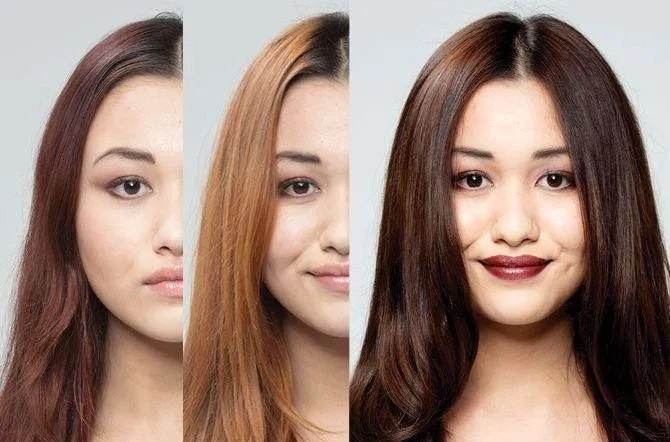Table of Contents
Embarking on a hair color journey can be exhilarating, but what happens when your desired shade turns into a disappointment? If you have naturally brown hair and recently dyed it black, you might be considering Color Oops as a solution.
In this comprehensive guide about Color Oops on Natural Brown Hair, we will explore the world of Color Oops and its effectiveness in removing black dye from natural brown hair. Furthermore, we’ll address the concerns surrounding potential hair damage, providing you with valuable insights and tips. Let’s dive into the realm of color correction and unlock the secrets of Color Oops!
Understanding Color Oops: The Magic of Color Removal

In this section, we will delve into the magic of Color Oops, exploring what it is, how it works, and how it differs from traditional bleach. Let’s uncover the secrets behind this revolutionary color correction product.
What Is Color Oops and How Does It Work?
Color Oops is a hair color removal system designed to eliminate artificial hair color molecules from your locks. Unlike traditional bleach, which lightens the hair by stripping away natural pigments, Color Oops works by reversing the chemical process that occurs during hair coloring. It breaks down the artificial color molecules, allowing them to be rinsed out.
The Ingredients of Color Oops
Color Oops typically contains a combination of reducing agents and conditioning agents. The reducing agents are responsible for breaking down the color molecules, while the conditioning agents help to minimize damage and maintain the hair’s moisture balance.
The Process of Color Removal
When Color Oops is applied to the hair, the reducing agents penetrate the hair shaft and react with the artificial color molecules. This reaction breaks the color molecules down into smaller particles that can be easily washed away during rinsing. The conditioning agents in Color Oops work to soften the hair and keep it in good condition throughout the process.
The Science Behind Color Oops: Breaking Down Artificial Color Molecules
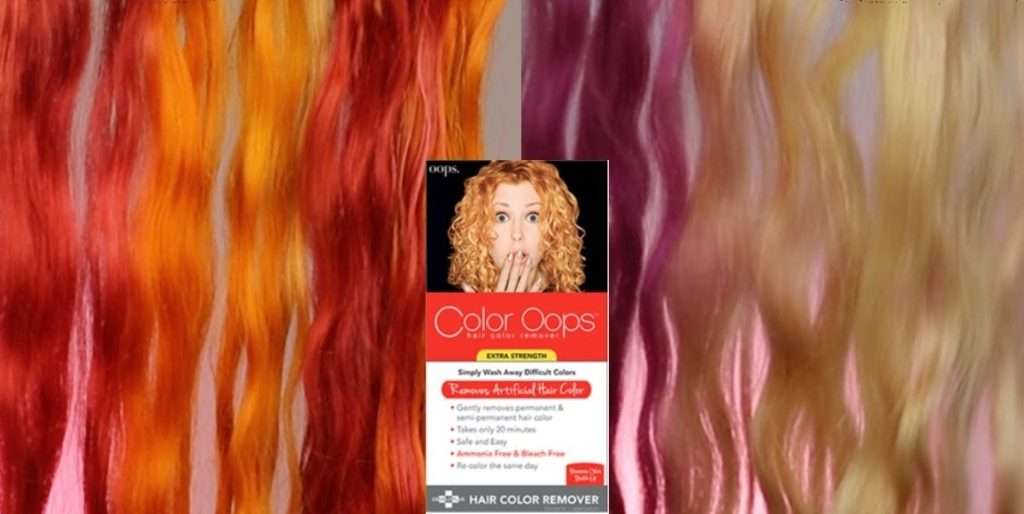
To understand how Color Oops effectively removes artificial color, it’s essential to grasp the science behind it. When you dye your hair, the color molecules penetrate the hair shaft and bind to the proteins within the hair fibers. Color Oops works by reversing this process, breaking the color molecules’ bonds and allowing them to be washed away.
Oxidative Hair Dyes
Most permanent hair dyes use oxidative dyes, which contain a colorless dye precursor and a developer. When mixed together, these components create a chemical reaction that produces the desired color. During this process, the color molecules form larger complexes that become trapped within the hair shaft.
Breaking Down the Color Molecules
Color Oops contains reducing agents that work to break the bonds formed by the color molecules. These reducing agents act as electron donors, effectively neutralizing the oxidative dye. As a result, the color molecules are fragmented into smaller particles that can be easily removed from the hair.
Color Oops vs. Traditional Bleach: A Gentle Approach to Color Correction
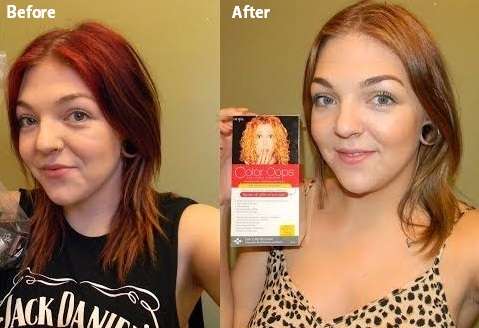
One significant advantage of Color Oops over traditional bleach is its gentle approach to color correction. While bleach strips away the natural pigments in the hair, often causing significant damage, Color Oops aims to remove color without causing excessive harm.
Minimizing Hair Damage
Color Oops is formulated to be less damaging than bleach. While some damage may occur due to the chemical process, Color Oops is generally considered a milder option. However, it’s important to note that individual results may vary, and proper hair care and conditioning after color removal are crucial to minimize potential damage.
Preserving Hair Integrity
Unlike bleach, which leaves the hair porous and prone to damage, Color Oops works to maintain the hair’s integrity. The conditioning agents present in Color Oops help to nourish and moisturize the hair, minimizing the risk of dryness and breakage.
Suitable for Multiple Color Corrections
Another advantage of Color Oops is its versatility. While bleach is primarily used for lightening the hair, Color Oops can be used to remove a wide range of artificial colors. Whether you’re looking to remove black, red, or even vibrant fashion colors, Color Oops provides a gentle yet effective solution.
Factors to Consider: Removing Black Dye from Natural Brown Hair
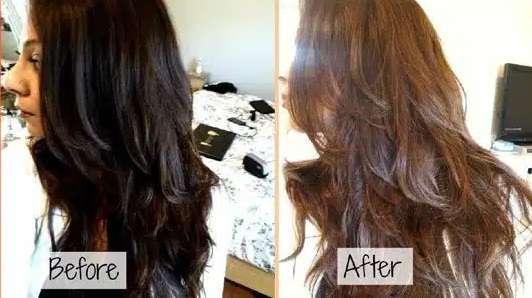
Removing black dye from natural brown hair can be a complex process that requires careful consideration. Various factors come into play when using a product like Color Oops to achieve the desired outcome.
In this section, we will explore three crucial factors to keep in mind: hair porosity, the intensity of black dye, and the timing of Color Oops application. Understanding these factors will help you manage expectations and maximize the effectiveness of color removal. Let’s delve into the key players in the color removal process.
Will Color Oops remove black dye from my naturally brown hair? And will it damage my hair after use?
Yes. Color Oops can remove black dye from naturally brown hair. While it can be effective, the results may vary depending on factors like the intensity of the black dye and the hair’s porosity. It’s important to note that using Color Oops may cause some hair damage, although it is considered a gentler alternative to traditional bleaching methods.
Hair Porosity: A Key Player in the Color Removal Process
Hair porosity refers to the hair’s ability to absorb and retain moisture and chemicals. It plays a significant role in the color removal process. Understanding your hair’s porosity level can help you anticipate how it will react to Color Oops.
Low Porosity Hair:
If you have low porosity hair, the cuticles are tightly closed, making it challenging for color molecules to penetrate. In this case, black dye removal may be more challenging, and multiple Color Oops applications might be necessary. It’s crucial to ensure thorough saturation and follow the instructions carefully for optimal results.
High Porosity Hair:
High porosity hair has open cuticles, which makes it more susceptible to color absorption. While this may sound beneficial for color removal, it can also lead to the hair easily absorbing new color molecules. It’s important to be cautious and closely monitor the color removal process to avoid unintended color shifts.
The Intensity of Black Dye: Managing Expectations and Outcomes
The intensity of the black dye used in your hair affects the color removal process and the outcome you can expect. Black dye typically contains higher levels of pigments, making it more challenging to remove entirely.
Moderate Black Dye:
If you used a moderate black dye shade, you have a higher chance of successful color removal with Color Oops. However, it’s important to understand that complete removal back to your original brown shade may not be achieved. There might still be some residual color or a lighter brown shade left.
Intense Black Dye:
If you used an intense black dye, achieving a complete removal of the color may be more difficult. Color Oops can help fade the color, but it might not be able to completely eliminate all traces of the intense black shade. Prepare yourself for the possibility of achieving a lighter brown or dark brown result rather than a full color reversal.
Time Since Dye Application: When Is the Right Moment to Use Color Oops?
The timing of Color Oops application plays a crucial role in the effectiveness of color removal. It’s essential to wait for the right moment to achieve the best results.
Freshly Dyed Hair:
Using Color Oops immediately after dyeing your hair black is generally not recommended. Allow at least a week for the color to settle and oxidize. This waiting period allows the color to stabilize, making it easier for Color Oops to break down the artificial color molecules.
Faded Black Dye:
If you have previously dyed your hair black, but the color has faded significantly, it might be the right time to use Color Oops. Faded black dye is generally easier to remove compared to fresh color applications.
A Step-by-Step Guide to Using Color Oops on Natural Brown Hair
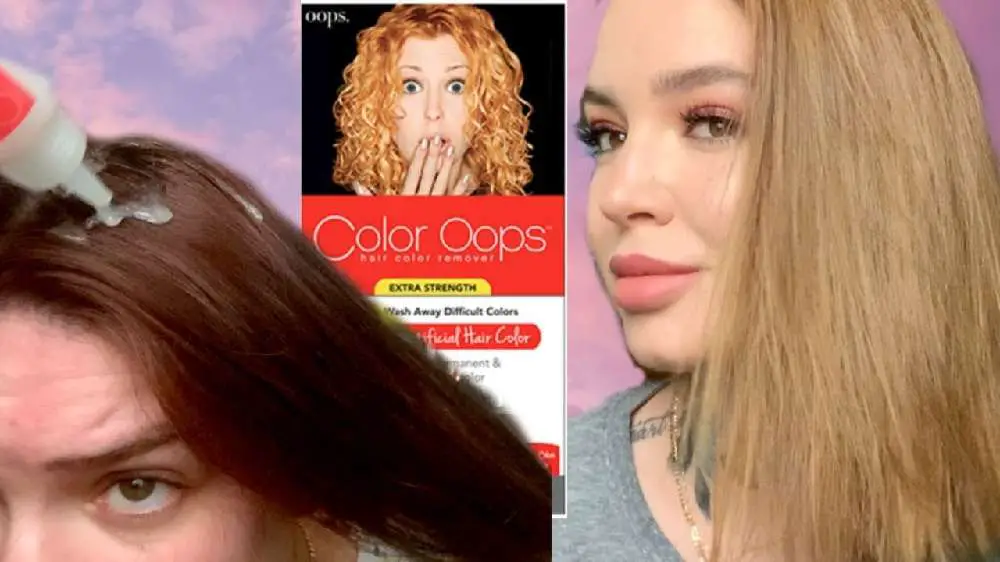
Using Color Oops to remove black dye from natural brown hair requires careful execution and adherence to proper techniques. In this section, we will provide you with a step-by-step guide to help you navigate the color removal process successfully.
From preparing for color removal to ensuring even distribution and effectively rinsing out the product, we will cover all the essential aspects. Let’s dive into the comprehensive guide for using Color Oops on natural brown hair.
Preparing for Color Removal: Strand Testing and Safety Precautions
Before applying Color Oops on natural brown hair, it’s crucial to perform a strand test to assess the product’s impact on your hair and anticipate the color outcome. Follow these steps:
- Choose a small section of hair, preferably from a discreet area.
- Apply Color Oops according to the instructions, focusing on the selected strand.
- Observe the color change and evaluate the results.
- If you’re satisfied with the strand test outcome, you can proceed with the full application. If not, adjust the processing time or consider alternative options.
Additionally, it’s essential to take safety precautions during the application process:
- Wear gloves to protect your hands from potential staining.
- Apply Color Oops in a well-ventilated area to avoid inhaling fumes.
- Protect your clothing and surfaces from potential stains by using a towel or cape.
Application Techniques: Ensuring Even Distribution of Color Oops
To achieve optimal results and ensure even color removal, follow these techniques for applying Color Oops:
- Divide your hair into manageable sections using clips or hair ties.
- Start applying Color Oops from the roots, working your way down to the ends.
- Use a comb or your fingers to distribute the product evenly, ensuring every strand is coated.
- Pay special attention to areas where the black dye is more concentrated, such as the ends or previously dyed sections.
- Avoid applying excessive product, as it may lead to uneven results or unnecessary damage.
The Importance of Processing Time: Patience Is a Virtue
The processing time of Color Oops is crucial for achieving desired color correction results. Follow these guidelines:
- Refer to the instructions provided with Color Oops for the recommended processing time.
- Set a timer to ensure accuracy and avoid leaving the product on for too long.
- Remember that longer processing time does not guarantee better results. Stick to the recommended time to minimize potential hair damage.
- Use a mirror or timer app to keep track of the time while you wait patiently.
Rinse and Shampoo: Removing Color Oops Residue Effectively
Proper rinsing and shampooing are vital to remove Color Oops residue and prepare your hair for further treatment. Follow these steps:
- Thoroughly rinse your hair with warm water, ensuring all areas are rinsed.
- Rinse for a longer duration to ensure complete removal of the Color Oops product.
- Apply a clarifying or color-safe shampoo and massage it into your hair and scalp.
- Rinse your hair again to remove any shampoo residue.
- Condition your hair with a moisturizing conditioner to restore hydration and nourishment.
Remember to follow any additional instructions provided with the Color Oops product for the best results.
Managing Expectations: The Journey from Black to Brown Hair
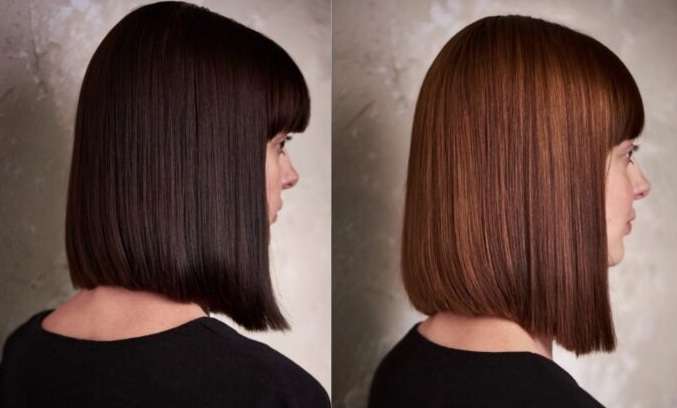
Transitioning from black to brown hair can be an exciting journey, but it’s important to manage your expectations and understand the factors that can influence the outcome.
In this section, we will explore three key factors that play a role in achieving your desired shade of brown: color variation, hair texture and color depth, and post-treatment care.
By considering these factors and implementing proper hair care practices, you can navigate the journey from black to brown with confidence. Let’s delve into managing expectations for your hair transformation.
Color Variation: Achieving a Lighter Shade of Brown
When removing black dye and aiming for a brown shade, it’s essential to understand that achieving a lighter tone may require multiple color removal sessions or additional hair treatments. Factors that influence color variation include:
Underlying Pigments:
As you transition from black to brown, your natural hair color and underlying pigments come into play. Darker underlying pigments can affect the final shade, resulting in a deeper brown color rather than a light or medium brown.
Multiple Color Removal Sessions:
If your hair has been dyed black for an extended period or if the black dye is intense, it may take several color removal sessions to reach your desired shade of brown. Be patient and allow ample time between treatments to minimize hair damage.
Toning and Color Depositing:
To achieve the desired brown shade, you may need to tone your hair or deposit a brown color after the color removal process. This additional step can help neutralize any unwanted tones and enhance the overall result.
Hair Texture and Color Depth: Individual Factors Influencing Results
Hair texture and color depth can significantly impact the outcome of your transition from black to brown. Consider the following factors:
Porosity and Absorption:
Hair porosity affects how well your hair absorbs and retains color. High porosity hair may absorb color more easily, resulting in a deeper brown shade, while low porosity hair may require more effort to achieve the desired color.
Previous Damage and Treatments:
If your hair has undergone previous damage from heat styling, chemical treatments, or excessive dyeing, it may be more challenging to achieve an even and consistent brown color. Be prepared for variations in color depth and consider professional assistance if needed.
Natural Hair Color:
Your natural hair color and pigmentation can influence the outcome of the color removal and transition process. Darker natural hair colors may require additional treatments or color adjustments to achieve the desired brown shade.
Post-Treatment Care: Nourishing Your Hair Back to Health
After removing black dye and transitioning to brown, it’s crucial to prioritize post-treatment care to restore and maintain the health of your hair. Follow these essential care practices:
Moisturizing and Conditioning:
Color removal processes can strip the hair of moisture, making it dry and prone to damage. Use hydrating shampoos, conditioners, and deep conditioning treatments to replenish moisture and nourish your hair.
Avoiding Heat Styling:
Limit the use of heat styling tools such as flat irons and curling irons to prevent further damage. Embrace natural hairstyles and opt for heat-free styling methods whenever possible.
You may also read: Is my hair black or brown? (Answered)
Protective Styling:
Consider protective hairstyles such as braids, buns, or updos to minimize exposure to environmental factors and reduce friction that can cause breakage.
Regular Trims:
Schedule regular trims to remove any split ends and promote healthy hair growth. Trimming helps maintain the overall appearance and condition of your hair during the transition period.
Addressing Concerns: Hair Damage and Color Oops
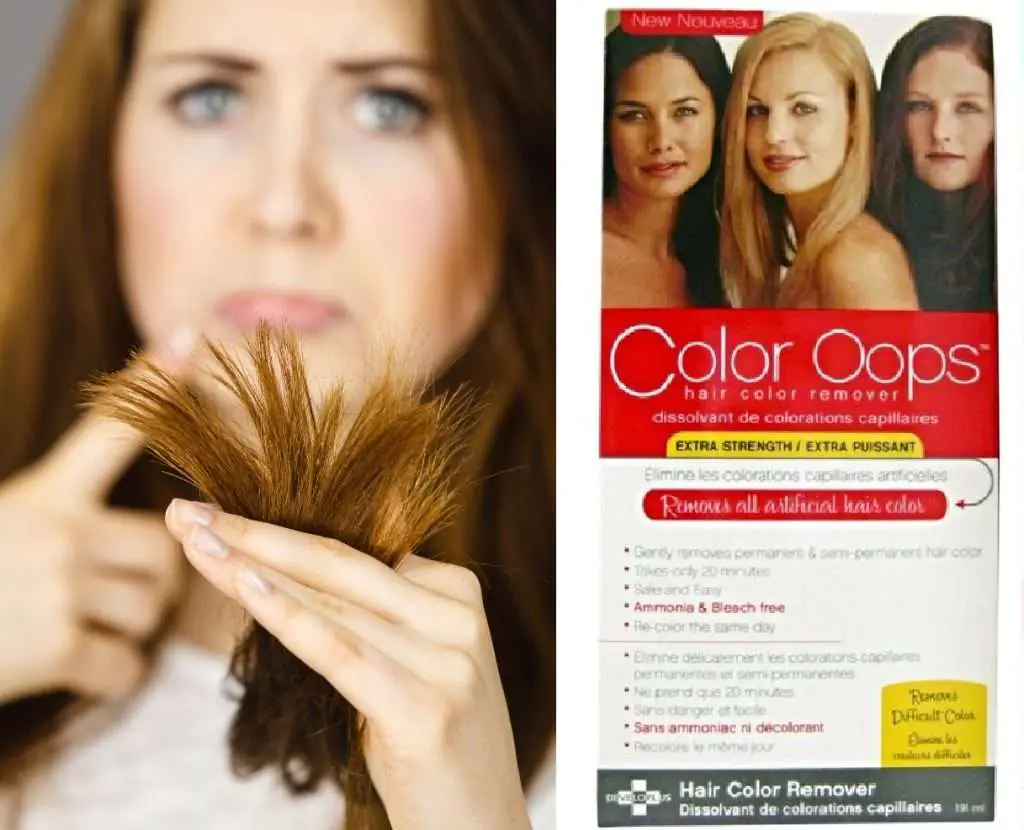
When it comes to removing black dye from natural brown hair, concerns about potential hair damage are common. In this section, we will address these concerns and provide insights into the effects of Color Oops on your hair.
We will explore the potential for hair damage, compare Color Oops to other methods, and offer tips for post-treatment hair restoration. By understanding these aspects, you can make informed decisions and take steps to minimize damage during the color removal process. Let’s dive into addressing concerns about hair damage and Color Oops.
Understanding the Potential for Hair Damage
It’s natural to be concerned about potential damage when using color removal products. However, it’s important to note that Color Oops is designed to be a gentle and less damaging alternative to traditional bleach. Understanding the factors that can contribute to hair damage can help manage your expectations:
Chemical Composition:
Color Oops contains reducing agents that break down artificial color molecules. While these agents are generally milder than bleach, they can still have some impact on the hair’s structure. It’s crucial to follow the instructions carefully to minimize potential damage.
Porosity and Hair Condition:
Hair that is already damaged, porous, or weakened by previous chemical treatments may be more susceptible to damage during the color removal process. It’s advisable to assess your hair’s condition before using Color Oops and consider professional assistance if your hair is severely damaged.
Overprocessing and Repeated Use:
Excessive or improper use of color removal products can lead to hair damage. It’s essential to avoid overprocessing your hair or using Color Oops more frequently than recommended. Follow the instructions provided and allow sufficient time between color removal sessions to minimize potential damage.
Minimizing Damage: How Color Oops Compares to Other Methods
When comparing Color Oops to other color removal methods, it’s important to consider the potential for damage:
Bleaching:
Traditional bleaching methods involve the use of harsh chemicals to lighten and remove color from the hair. Bleaching can cause significant damage, including dryness, breakage, and loss of hair elasticity. In comparison, Color Oops is generally considered a gentler option with a reduced risk of severe damage.
Color Stripping/Shampooing:
Some color stripping or clarifying shampoos claim to remove hair color. However, these products can be harsh and may lead to dryness and damage with prolonged use. Color Oops, with its targeted formula, is formulated specifically for color removal, offering a more controlled and focused approach.
Hair Restoration: Tips for Post-Treatment Recovery
After using Color Oops or any color removal product, it’s essential to prioritize hair restoration to minimize damage and promote healthy hair growth:
Deep Conditioning Treatments:
Use deep conditioning treatments regularly to restore moisture and nourishment to your hair. Look for products specifically designed to repair and strengthen chemically treated hair.
Protein Treatments:
Consider incorporating protein treatments into your hair care routine. Protein helps fortify the hair shaft, improving its strength and resilience. Choose protein treatments that are suitable for your hair type and follow the instructions for best results.
Gentle Hair Care Practices:
Handle your hair with care and adopt gentle hair care practices. Avoid excessive heat styling, minimize the use of harsh hair products, and opt for wide-toothed combs or brushes with soft bristles to prevent unnecessary breakage.
Regular Trims:
Schedule regular trims to remove any damaged or split ends. Trimming helps maintain the health and appearance of your hair, allowing it to grow stronger and more vibrant.
Healthy Lifestyle:
Maintain a healthy lifestyle by eating a balanced diet, staying hydrated, and getting enough rest. These factors contribute to overall hair health and can aid in the recovery process.
Color Oops Alternatives: When Color Oops Isn’t the Ideal Choice
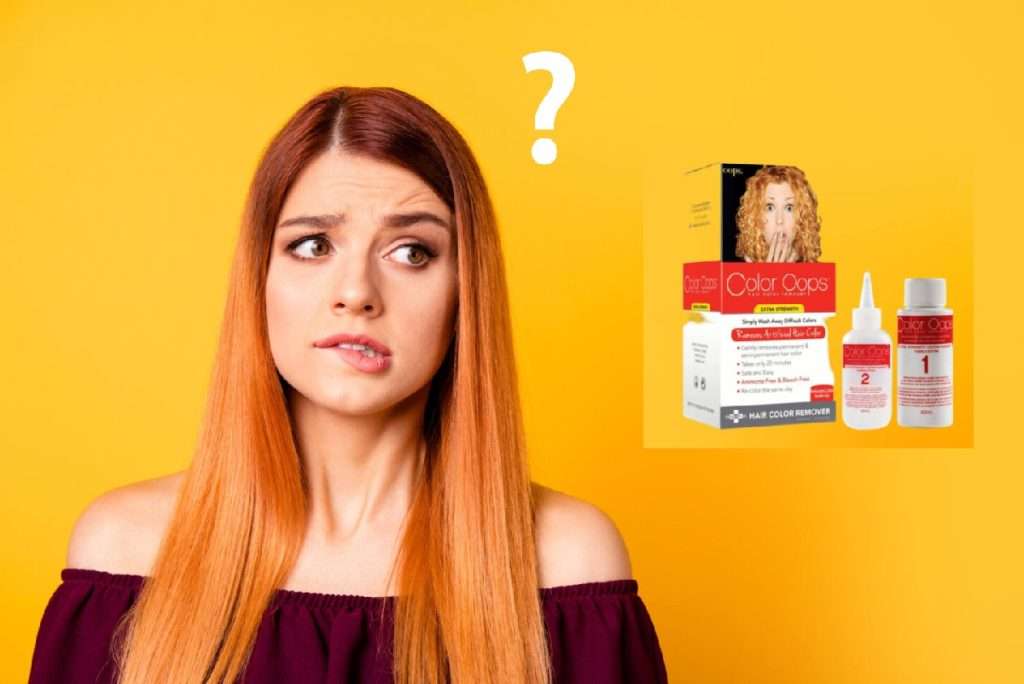
While Color Oops is a popular option for removing black dye from natural brown hair, there may be situations where it isn’t the ideal choice. In this section, we will explore alternative solutions for those instances when Color Oops may not provide the desired results.
We’ll discuss seeking professional help through a consultation with a hair color specialist and the possibility of bleaching as a final resort for stubborn black dye. By considering these alternatives, you can make informed decisions and explore the best options for your specific hair color needs. Let’s explore alternative solutions when Color Oops isn’t the ideal choice.
Seeking Professional Help: Consultation with a Hair Color Specialist
If you’re unsure about using Color Oops or if you’ve attempted color removal with unsatisfactory results, it’s highly recommended to seek professional help from a hair color specialist. Here’s why a consultation with an expert can be beneficial:
Assessment of Hair Condition:
A hair color specialist can assess the current condition of your hair, including its health, porosity, and any existing damage. They can determine the best course of action based on your hair’s unique characteristics.
Tailored Color Correction:
Hair color specialists have extensive knowledge and experience in color correction techniques. They can create a customized plan to safely and effectively remove black dye from your natural brown hair, taking into account your desired outcome and minimizing potential damage.
Advanced Color Removal Methods:
Hair color specialists have access to professional-grade color removal products and techniques that may yield better results than over-the-counter options. They can utilize specialized products and processes to achieve the desired color correction while prioritizing the health of your hair.
Professional Expertise and Experience:
Hair color specialists undergo rigorous training and have a deep understanding of color theory, chemical interactions, and hair structure. Their expertise ensures that color removal is performed accurately and safely, providing you with the best possible outcome.
Bleaching: The Final Resort for Stubborn Black Dye
In some cases, when black dye is deeply saturated or resistant to color removal methods, bleaching may be considered as a last resort. It’s important to note that bleaching is a highly transformative and potentially damaging process. Here are some key considerations:
Professional Assistance:
Bleaching should only be performed by a trained professional to minimize the risk of hair damage. A professional colorist can assess your hair’s condition and determine the safest and most effective approach to achieve your desired color outcome.
You may also read: How To Dye Your Hair At Home By Yourself: Comprehensive Guide
Gradual Lightening:
Bleaching is typically done in multiple sessions to gradually lighten the hair. This approach helps minimize damage and allows for better control over the lightening process.
Post-Bleaching Care:
Bleaching can leave the hair more vulnerable and prone to dryness and damage. Following a strict post-bleaching hair care routine, including deep conditioning, gentle styling practices, and regular trims, is crucial to restore and maintain hair health.
Color Depositing and Toning:
After bleaching, color depositing or toning treatments may be necessary to achieve the desired brown shade. These steps help neutralize unwanted tones and enhance the final color result.
Color Oops on natural hair (Video)
Conclusion
Color Oops serves as a valuable ally in the quest to remove black dye from natural brown hair. By understanding its mechanism, managing expectations, and following proper procedures, you can embark on a successful color correction journey.
Remember to prioritize hair health and explore professional assistance when needed. With Color Oops as your companion, bid farewell to unwanted black dye and welcome the vibrant world of natural brown hair once again!
Frequently Asked Questions (FAQs):
Q1: Can Color Oops completely remove black dye from my natural brown hair?
A1: While Color Oops aims to remove artificial color, complete removal of black dye from natural brown hair may not always be achievable. Results can vary based on several factors.
Q2: How soon can I use Color Oops after dyeing my hair black?
A2: It is generally recommended to wait for at least a week after dyeing your hair black before using Color Oops. This allows the color to settle and minimizes the risk of potential damage.
Q3: Will Color Oops restore my hair to its original brown shade?
A3: Color Oops helps fade artificial color, but it may not restore your hair to its exact original brown shade. There may be some color variation due to the underlying pigments and the dye’s intensity.
Q4: Can Color Oops be used on previously dyed hair other than black?
A4: Yes, Color Oops is effective on a range of artificial hair colors, not just black. It can help fade various shades, allowing you to transition to a different color more easily.
Q5: Is it necessary to follow up with deep conditioning treatments after using Color Oops?
A5: Yes, post-treatment care is crucial. Deep conditioning treatments help restore moisture, nourish the hair, and maintain its health after undergoing color correction processes.
Editors pick: Color Oops on Dirty Hair: Unraveling its Potential and Promises
